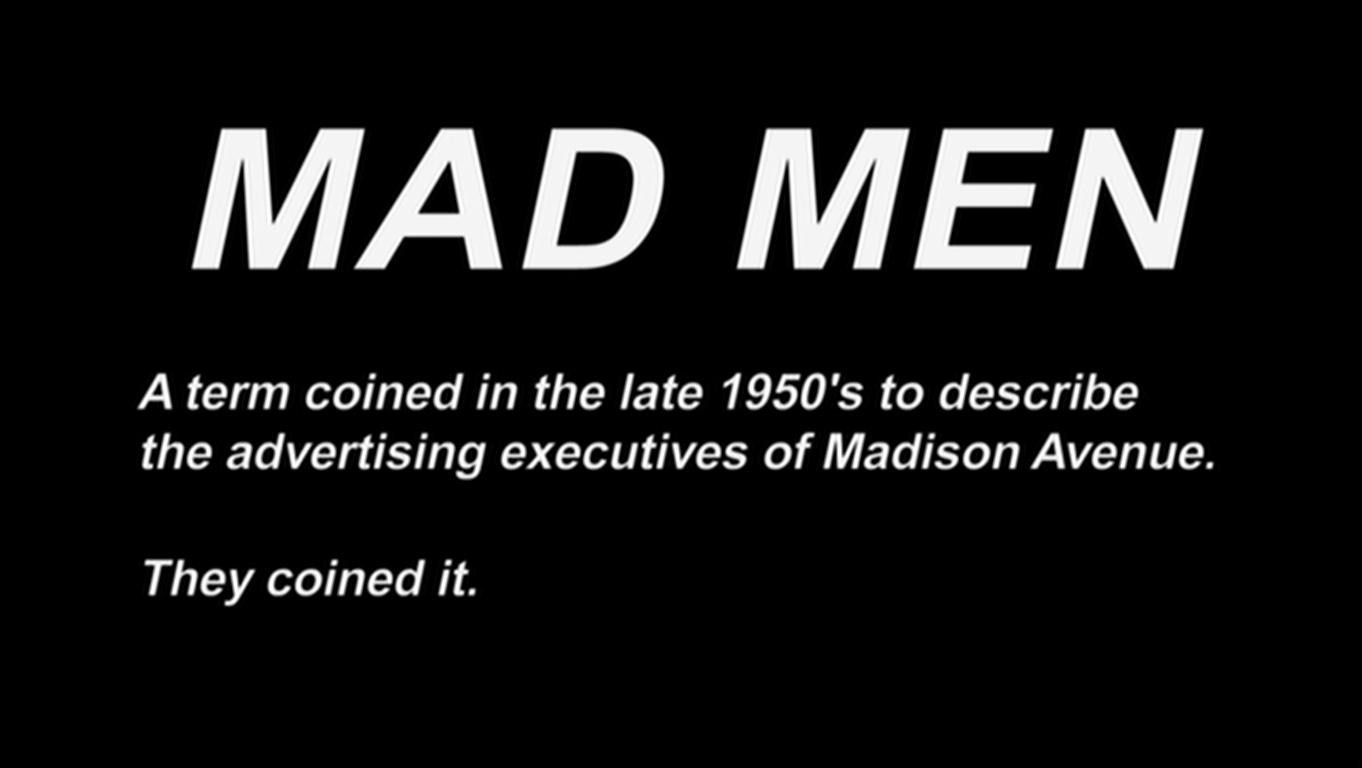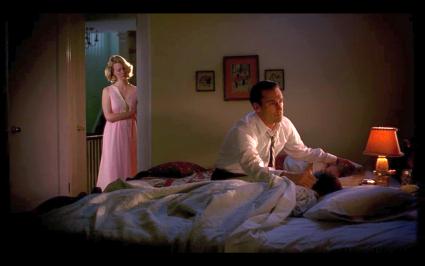Ending things is hard. I think most people are aware of that. And judging by how many shows end in ways that make people complain for decades, even the best writers have a tough time sticking the landing.
What doesn’t get talked about as much, though, is how beginning things is also really tough. You have to introduce characters, setup the world, get the story into motion, set yourself up for later success. And, oh yeah, you have to suck the audience in and make them want more. Not easy.
But the Mad Men pilot, “Smoke Gets in Your Eyes” is one of those that does it right.
I had originally planned on watching the show and offering no more than a tweet on each episode; however, when I re-watched the pilot I realized how effective it was, and how it offered so many lessons to anyone else wanting to make a pilot that did things right.
I just hope this inspiration doesn’t happen 91 more times with all the other episodes.
I recommend watching or re-watching it too at some point to observe how it did all these things, but even if you’ve never seen it, these lessons will still make sense and help your writing.
So mix an old-fashioned and get your pack of cigarettes ready; we’re going to look at the show.
1. Captivate with your beginning
You only have one chance to make a first impression. If you don’t capture your audience’s attention right away, you’ve already lost them, which is why many shows start with some sort of exhilarating scene.
Mad Men doesn’t do this. In fact, it starts with as close to the opposite of an action scene that exists: a black screen with a bunch of words on it.
These words are captivating though. Not only does it answer the question of “what does this title mean,” but it sets up the kind of people that we’re going to be dealing with. The type of people who would coin their own nickname. And the type of people who would probably brag about how they just “coined it.”
It’s important to ask yourself the question “what would draw me in and make me want to see more?”
After the black screen, the show takes us into a bar where it patiently shows the world of 1960. That leads us into
2. Setup a an immersive world
The show begins in the 60’s, but it’s a 60’s that’s still very much the 50’s. The music, the atmosphere, the fact that everyone inside is smoking makes us feel what it’s like to be here. We’re shown both the glamour and the ugliness of it.
In your pilot, you’re taking the audience on a journey, and it’s crucial to let them actually feel the world, whether it’s an ad agency in the 60’s, Westeros, or the dating scene in New York.
The more removed the place is from our everyday lives, the more important it is that it’s clearly shown so that the audience can feel like they’re in it.
Throughout the rest of the episode, we are always reminded of the world that we’re in, sometimes by the ways characters speak to each other, sometimes by the fashion or outdated technology, and sometimes by the references to what’s going on at the time (I had no idea Nixon was thought of as a handsome hero).
If your world isn’t as removed from ours as the 60’s, you can still do this by setting up a strong consistent tone. Breaking Bad’s world is modern and in the middle of the U.S. but it always has such a specific feel (the style, the colors, the locations) that when we watch its spinoff, Better Call Saul, we know we’re in the same place.
3. Create nuanced characters
In order to get the audience to keep coming back, you NEED to have interesting characters (especially in a character-driven piece like this show). And in order for the characters to be interesting, they have to feel like real people. This means that they have multiple sides to them.
These sides should be presented in the opening episode. You may think “my characters might be one-sided now--but just wait until they get to episode nine, hahahah,” but if the audience checks out before then because they can’t connect with the character, episode nine doesn’t mean shit.
This means giving your good characters a flaw and your giving bad characters something to like. I talk about this more in my article Shades of Gray.
The show shows multiple sides of its main characters, making them much more interesting. We see Don Draper as the lover, the man who’s in control, the man who’s not in control, the friend, the adversary, the tough boss, and the husband/ father.
At his dinner with Rachel, when we get on his face how much she pegged him for who he really is, we know that there’s a whole side to him that no one else is likely privy to.
Pete also shows himself as a very different person when he’s hanging with his friends, vs when he’s trying to seem cool to Don, vs. when he’s sucking up to Don, vs. when he’s being sincere to Peggy.
Peggy, who seems wholesome, surprises us when she first makes a move on Don and then invites Pete into her house at the end.
These characterizations can be shown through dialogue, but they can also be shown through great acting.
One thing to be careful of is going too far and having the character do something that is not believable (often this character sacrifice is in service of the plot). If Peggy and Pete were planning Don’s murder at the end instead of making out, it might have been interesting, but the audience’s BS meters would be ringing, and that’s never good.
This means that you have to treat your characters as real people and always know where their heads are at. An audience is good at knowing when a writer is manipulating a character like a marionette.
4. Accomplish multiple things at once
At the beginning I mentioned all of things you typically need to do when beginning a story. There’s a lot of items there, especially if you have an ensemble cast, so there can’t be wasted moments.
And in order for the pilot to not be seven hours long, you need to be able to accomplish multiple things at once.
There’s an elevator scene early on in the episode. Peggy, on her first day, gets onto an elevator. The characters Ken, Paul, and Harry get on. They joke about Pete Campbell getting married. Ken makes a me too worthy come-on (“I’m really enjoying the view from here”) to Peggy. She ignores it, and they leave the elevator.
This scene might not seem like it does a lot, but it actually accomplishes many things.
-It introduces us to four characters and their personalities
-It shows that Peggy is new
-It lets us feel this world of the 50’s through Peggy’s eyes
-It shows us that there is a boy’s club at this agency
-It lets us know there’s a character named Campbell, who’s important
-It tells us that Campbell is getting married
-It tells us Campbell's friends don’t take it seriously
-It tells us that Peggy is going to have to face a lot of things she’s not quite prepared to face
When you can have scenes accomplish a lot of things like this, you will have a tight script, and you will be able to get a lot of information across without it feeling like exposition.
5. Resolve
With narratives that have storylines spanning whole seasons and even whole shows, it’s common to assume that nothing will be wrapped up in the first episode. Frodo doesn’t toss the ring into the fires of Mordor in the first movie.
But even though you’re not going to resolve the stories in the episode, you still want the episode itself to feel resolved. The episode is a tiny complete project that makes up part of the giant complete project. That means the character or plot needs to make some sort of advancement or there needs to be payoffs.
Peggy begins her first day by having to deal with characters who tell her what to do: Don, Joan, the doctor. She does not have much autonomy throughout the episode. Even when she makes a move on Don, she’s doing so because she’s feeling like it’s part of the job. When she invites Pete into her apartment at the end, it’s the first time in the episode she’s taking real agency, which makes this feel like a complete piece for her.
Pete spends most of the episode trying to get approval from Don, with each attempt resulting in more setbacks. He’s scared scared of getting married, and his payoff at the end is him going against Don’s advice to not sleep with Peggy and goes to her apartment.
Don and Rachel’s storyline gets wrapped up too, at least the will-they won’t-they business aspect of it. When Rachel agrees to have Sterling-Cooper represent her, that is a resolution, although there’s more to come.
Don’s relationships have a payoff as well. He tells Midge they should get married at the beginning, then he flirts with Rachel later (though she’s presently having none of it), and at the end, the payoff is the reveal that he’s married with a family.
Payoffs like these will make the audience feel like they’re watching complete pieces and this is what creates good episodes instead of just good seasons.
6. Use the three parts of the continuum
Imagine there’s a line running through everything that’s narrative. One one side of the line is the real and the literal: that’s drama. On the other side of the line there’s symbolism and bright colors and the abstract: that’s art. Where these two meet in the middle is comedy.
Great! So what?
So you want to tap dance all over that line.
Good shows and movies never stay in just one part of the continuum. They visit all three, and this show definitely accomplishes that well. There’s many scenes that do so, but I’ll point to the scene where Rachel is coming into Sterling Cooper for the meeting.
There’s the drama that fills the whole scene with the tension of Rachel demanding a certain type of branding for her company and Don undermining her decisions. The tension build as they argue, resulting in Don and Pete leaving the meeting
There’s also comedy in the scene, with Roger Sterling bringing in a guy from the mail-room to pose as someone from the art department just because he’s Jewish, which results in more comedy with his giant bloody mary.
As for the art, there’s the wardrobe, Rachel’s purple contrasting with the suits in the room. There’s the set decoration like the shrimp she puts her cigarette out on and the old-looking ads. And like most of the series, the camerawork and dialogue also function as art.
This type of play all across the spectrum causes scenes like this one to impact us in many ways.
7. Venture into darkness
One thing that we really advocate is looking at the darker parts of life (if the name Candivan isn’t indicative enough of that). All the greatest works do this to some degree or another. Even Pixar movies deal with dark themes like embracing death and loss of innocence. Pinocchio has kids turned into donkeys to be sold into slave labor. Dealing with this kind of darkness brings out a full truth in whatever story we’re telling and connects us more to it.
And of course, this pilot gets dark.
It doesn’t even have to try hard, since it starts in the a setting created by the 1950’s where racism and sexism are more common. We see this immediately with the way the manager treats the black waiter.
And Peggy’s scene with the doctor is UNCOMFORTABLE. Maybe it’s because he’s supposed to be a trusted medical professional, but the callowness in which he treats Peggy and how he tells her that he’s going to deny her birth control if she abuses it, makes us see some of the hard facts of the time.
One reason to show some of these sad situations is to give us some context for the things that the 60’s must overcome. Lingering in that darkness might be uncomfortable, but it creates a more authentic and engaging experience, and it’s a villain we want to see get destroyed.
8. Run theme through veins
I mention this a lot, but all great movies and shows have a central theme that connects everything together. It’s a statement or question that everything points back too, essentially the show’s thesis. I go into depth about it here.
You might be thinking “Who the hell cares? Only writing/ story nerds like you are going to notice!”
While it’s true that many viewers might not realize it consciously, it doesn’t make it any less important. This still registers with us whether or not we realize it. It’s what makes a movie or show feel like a cohesive piece instead of just a bunch of stuff that happened. It’s that seemingly intangible quality that makes us think that particular story worked.
The series of Mad Men as a whole is asking the question “Is change truly possible?”
This episode, however, seems to be saying something along the lines of “Things can only be ignored for so long.”
Everything in this episode shows us the end of an era that’s about to change. The 50’s, so full of glamour and superficial perfection. But there’s a lot under the surface that’s being ignored. Racism. Sexism. The fact that smoking will kill you. These things will all come to the forefront in the 60’s, and we’re seeing the end of one thing and the beginning of something else.
Don’s whole pitch to Lucky Strike demonstrates that. He’s talking to people who want to keep things the same, and his winning pitch is one that ignores the problem and instead focuses on how the tobacco is toasted. It’s something that both the psychologist and Pete feel should be done differently, but the old school approach still works…for now.
Rachel does not accept this kind of ignoring. She took over for her father’s company after bad results and wants to try a new approach: an approach of charging more and making sure that her company can’t be ignored.
The epitome of ignoring in this episode is with Don’s family. We don’t know of their existence until the very end of the episode. He acts like a single man, proposing to Midge and flirting with Rachel. He never once brings them up, which tells us that when he’s not with them physically, he’s not with them at all.
All of the main characters are trying to temporarily push something aside, but we know from the growing tension it won’t be ignored for long.
9. Setup for future episodes
So for sure we want to resolve things in every episode (see point 5), BUT we also want to set things up for future episodes and get the audience excited to watch them.
There’s a quick sequence early on where Don, completely alone, looks at a metal and then places in a book with his name on it. We don’t know what it means, but it’s a mystery, and it’s something that we anticipate we’ll find more about in later episodes.
The character dynamics also sets up a lot of expectations. What will happen between Don and Rachel? What about between Pete and Peggy? Will he still get married? Will the ad campaign for Lucky Strike work? Who exactly the hell is Don Draper? How will these characters deal with the changes the 60’s provide? How bad must have people’s clothes smelled with all that smoking?
These types of things create a journey that we don’t want to have to wait for. It’s what makes a bingeable show so bingeable.
With every episode of Mad Men that follows there’s even more we can learn from.
And while beginnings still remain tough, I hope this helps with how to approach it. The rest of the journey to come.
I have a feeling there will be more at looking at Mad Men and the hundreds of lessons we can take from it.
Thanks for reading! If you liked this, please join our mailing list: https://www.candivan.com/subscribe/
You can also follow us on Twitter and Instagram.
And if you haven't filled out our Demographics Survey yet, it would be a big help to our creators and would allow for more show opportunities. It's very quick, and we will give you a "thank you" on our homepage, along with any emoji of your choosing next to your name.










